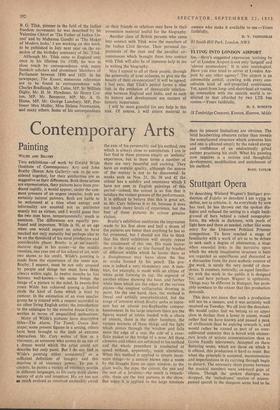Contemporary Arts
Painting
WILDE AND BRATBY
Two exhibitions—of work by Gerald Wilde (Institute of Contemporary Art) and John Bratby (Beaux Arts Gallery)—ask to be con- sidered together, for their similarities are as suggestive as their differences. Both these artists are expressionists, their pictures have been pro- duced rapidly, it would appear, under the con- stant pressure of an urgent impulse; both are certainly natural painters. Both are liable to be welcomed at a time when energy and informality are counted not as attributes merely but as virtues, and I would guess that the two men have, temperamentally, much in common. The differences are equally pro- found and important. Wilde is 50, at an age when one would expect an artist to have reached not only maturity but perhaps also to be on the threshold of his most productive and considerable phase. Bratby is at an equally decisive stage in his career--in the middle twenties, one year out of his school of art, with two shows to his credit. Wilde's painting is made from the experience of the inner eye. Bratby, I suspect, must be not only aroused by people and things but must have them always within sight. In twelve months he has become well-known — his name brings the image of a picture to the mind. In twenty-five years Wilde has achieved among a limited circle the kind of fame which is bred by rumour. In the estimation of an even smaller group he is treated with a respect accorded to no other living English artist; the introduction to the catalogue by the novelist Joyce Cary is written in terms of unqualified enthusiasm.
Many of Wilde's pictures have descriptive titles—The Alarm, The Tomb, Green Sea- scape; some present figures in a setting, others have been brought to the limit of extreme abstraction. Mr. Cary writes of him as a visionary, as someone who comes to us out of a dream world which the artist could not describe but only paint. But I do not find in Wilde's painting either consistency or a sufficient definition of imagery and this deprives it of visionary power. To put it crudely, he paints a variety of visionary worlds in different languages, as his early work shows variety of style and intention. His art has not sea much evolved as revolved unsteadily about the axis of his personality and his method, one which is always close to automatism. 1 can in fact find in these pictures simply an 'aesthetic' experience, but in these terms a number of them are very beautiful and exciting. They have an ecstatic quality, although the source of the ecstasy is not to be discovered. In works such as Nos. 21, 36, 38 and 42 the colour has a solidity and resonance which I have not seen in English paintings of this period—indeed, the colour is so fine that it subdues the violent gesture of the performance. It is difficult to believe that this is great art, as Mr. Cary believes it to be, because it does not touch many levels of experience, but the best of these pictures do arouse genuine elation.
Bratby's exhibition reinforces the impression made by his first show and half a dozen of the pictures are better than anything he has so far presented, but 1 should not like to think that his third exhibition will simply repeat the attainment of this one. His main instru- ment is the stroke or line formed by brushes of different widths which he leaves there as a draughtsman may leave alone the line or stroke formed by his pencil. The pro- cess is indeed a very elementary one. A tum- bler, for example, is made with an ellipse of white paint forming its top, the segment of another ellipse showing the base, and further white lines which are the edges of the various planes—the simplest calligraphic drawing in paint. On the one hand, then, the method is literal and artfully unsophisticated, but the range of interests which Bratby seeks to repre- sent has an almost pre-Raphaelite compre- hensiveness. In his large interiors there are the figures seated at tables loaded with a chaos of objects, there is the other furniture, the various textures of these things and the light which comes through the window and falls upon the edge of a cup, the side of a corn- flake packet or the bridge of a nose. All these elements and others arc subjected to his method and the whole procedure is conducted at speed without, apparently, much alteration. When this method is applied to simple inani- mate things—to a curtain blown into a room by the draught from an open window, to the plain walls, the pipe, the cistern, the pan and the seat of a lavatory—the result is remark- able; these are the best pictures in the show. But when it is applied to the large interiors then its present limitations are obvious. The bold handwriting obscures rather than reveals the complicated structure which concerns him and one is affected simply by the naked energy and confidence of an undoubtedly gifted painter practising his craft. What his painting now requires is a serious and thoughtful development, modification and enrichment of his method. his method.
BASIL TAYLOR
































 Previous page
Previous page